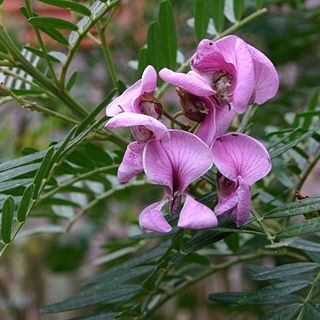Small tree, 4-8(-16) m high, with crown narrow or spreading. Bark smooth. Leaves very variable, imparipinnate. Leaflets in (2-)7-9(-16) pairs, subsessile, linear to narrowly ovate, with a short, apical mucro, glabrescent at maturity or pubescent along midrib abaxially. Stipules linear, acuminate. Inflorescence an often congested and umbel-like raceme with flowers opening ± simultaneously. Flowers rose-violet or violet-purple, rarely pale pink, but then with beak dark purple; bracts small, caducous. Flowering time Aug.-Jan., with peak in Oct. Pod dehiscent, sometimes only along upper suture, coriaceous or sometimes woody, linear to linear-oblong, 2-valved.
A small tree. It grows 8-16 m tall. The trunk can be 60 cm across. The leaves have leaflets along the stalk. There are 7-9 pairs. They are narrowly oval. The flowers are in a compact group that open at the same time. The pods are 12 mm wide. The seeds are small.
Small tree to 16 m. Leaves pinnate, leaflets glabrescent, oblong, obtuse to emarginate. Flowers in axillary racemes, violet with dark purple keel tip, bracts small, caducous before buds 5 mm long.


